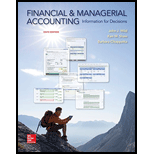
Concept explainers
Liability Account:
A liability account may be regarded as the account depicting the burden or the obligatory aspect related to a transaction and that it is to be fulfilled in the near future. They mainly form part of the financial statements so that the end users may analyze the current standing of the entity in terms of its liabilities against the possession of its assets.
Cash Account:
Cash account forms part of the assets of the company, or rather more specifically it is the part of current assets of the company. Cash account reveals the liquidity position of the firm in order to meet its obligations in the near future.
Revenue Account:
Revenue account forms the part of revenue in chart of accounts and depicts the value earned by the company on account of its core activities of business.
Asset Account:
An asset account reveals the value of current and fixed assets held by the company whether in tangible or intangible form. The company acquires assets based on the nature of benefits to be acquired from them. Short-tem benefits are gained from current assets as they provide liquidity to the firm, whereas on the other hand fixed assets' benefits are spread over its life span and they are not acquired to reap profits in the near future.
Equity Account:
An ownership interest in any kind of security or it may also be regarded as the difference value of the assets held and liabilities against the said assets. Also, in the financial statement of the company the funds contributed by the owners and any of the retained or ploughed back earnings (or losses) are regarded as shareholder's equity and recorded in equity account.
To identify: The entries to record the given transaction.
Want to see the full answer?
Check out a sample textbook solution
Chapter 2 Solutions
Financial and Managerial Accounting: Information for Decisions
- How many board feet of wood does tropic need to purchase in February ?arrow_forwardI am trying to find the accurate solution to this general accounting problem with appropriate explanations.arrow_forwardKyle had a gross weekly paycheck of $912 last week. Kyle worked 6 hours for 4 of the days and 8 hours on 1 day. What is Kyle's hourly rate of pay? Help with this questionarrow_forward

 AccountingAccountingISBN:9781337272094Author:WARREN, Carl S., Reeve, James M., Duchac, Jonathan E.Publisher:Cengage Learning,
AccountingAccountingISBN:9781337272094Author:WARREN, Carl S., Reeve, James M., Duchac, Jonathan E.Publisher:Cengage Learning, Accounting Information SystemsAccountingISBN:9781337619202Author:Hall, James A.Publisher:Cengage Learning,
Accounting Information SystemsAccountingISBN:9781337619202Author:Hall, James A.Publisher:Cengage Learning, Horngren's Cost Accounting: A Managerial Emphasis...AccountingISBN:9780134475585Author:Srikant M. Datar, Madhav V. RajanPublisher:PEARSON
Horngren's Cost Accounting: A Managerial Emphasis...AccountingISBN:9780134475585Author:Srikant M. Datar, Madhav V. RajanPublisher:PEARSON Intermediate AccountingAccountingISBN:9781259722660Author:J. David Spiceland, Mark W. Nelson, Wayne M ThomasPublisher:McGraw-Hill Education
Intermediate AccountingAccountingISBN:9781259722660Author:J. David Spiceland, Mark W. Nelson, Wayne M ThomasPublisher:McGraw-Hill Education Financial and Managerial AccountingAccountingISBN:9781259726705Author:John J Wild, Ken W. Shaw, Barbara Chiappetta Fundamental Accounting PrinciplesPublisher:McGraw-Hill Education
Financial and Managerial AccountingAccountingISBN:9781259726705Author:John J Wild, Ken W. Shaw, Barbara Chiappetta Fundamental Accounting PrinciplesPublisher:McGraw-Hill Education





